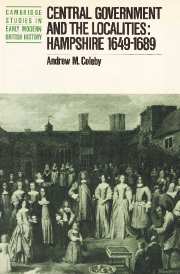Book contents
- Frontmatter
- Contents
- List of maps
- Acknowledgements
- List of abbreviations
- INTRODUCTION AND PROLOGUE
- PART I THE INTERREGNUM
- PART II THE RESTORATION
- PART III FROM THE POPISH PLOT TO THE REVOLUTION OF 1688
- 7 LOCAL OFFICE-HOLDING 1679-88
- 8 THE ENFORCEMENT OF POLICY 1679–88
- 9 COURT AND COUNTY 1679–88
- EPILOGUE AND CONCLUSION
- Bibliography
- Index
8 - THE ENFORCEMENT OF POLICY 1679–88
Published online by Cambridge University Press: 14 October 2009
- Frontmatter
- Contents
- List of maps
- Acknowledgements
- List of abbreviations
- INTRODUCTION AND PROLOGUE
- PART I THE INTERREGNUM
- PART II THE RESTORATION
- PART III FROM THE POPISH PLOT TO THE REVOLUTION OF 1688
- 7 LOCAL OFFICE-HOLDING 1679-88
- 8 THE ENFORCEMENT OF POLICY 1679–88
- 9 COURT AND COUNTY 1679–88
- EPILOGUE AND CONCLUSION
- Bibliography
- Index
Summary
DEFENCE AND INTERNAL SECURITY
The atmosphere of conspiracy between 1678 and 1683, followed by the rebellions of 1685, and their suppression, and the Dutch invasion of 1688 gave central government ample cause to be involved in managing defence and security arrangements at local, especially in strategically vital areas like the Solent. Though the means changed over the period, both Charles II and James II insisted on keeping these arrangements under their own control. On 30 November 1678, Charles rejected a militia bill on the grounds that it would take the militia out of his control, which he would not tolerate even for half an hour. Over the next seven years, control over the personnel and activities of local lieutenancies remained strong. J. H. Plumb has written about the country gentry that ‘in the last resort they controlled the militia’. During the 1680s, many gentry had cause to wish that this were true. In fact, ultimate control over the militia lay with the Crown. The gentry were powerless to prevent James II's move to reliance on a standing army to meet defence and security needs, indeed, Professor Schwoerer has written of the majority of the gentry in the 1685 Parliament: ‘It may be argued that if James had asked for a standing army officered by Protestants, he could probably have won it from this Parliament.’
- Type
- Chapter
- Information
- Central Government and the LocalitiesHampshire 1649-1689, pp. 179 - 206Publisher: Cambridge University PressPrint publication year: 1987
- 1
- Cited by

